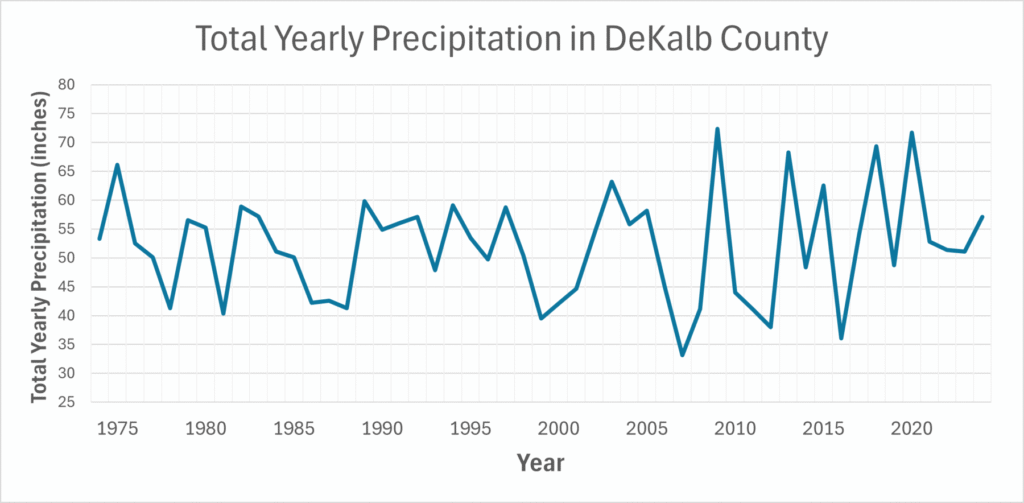This May, DeKalb County received 7.77 inches of rain – more than double the monthly average of 3.86 inches according to historical data from the National Centers for Environmental Information (NCEI). June also experienced excessive rainfall, totaling 6.00 inches, well above its monthly average of 3.93 inches. These patterns are consistent with conditions observed across Georgia this year, with many areas receiving record breaking rainfall, including those typically experiencing drought.
Rising temperatures are a driving factor behind these extreme rainfall events. According to EPA, 2024 was the second warmest year ever recorded in Georgia based on records dating back to 1895 (EPD, 2024 Climate Summary – Georgia). Warmer ocean temperatures lead to increased evaporation, adding more moisture to the atmosphere and fueling heavier precipitation events.
Climate is often misinterpreted as “average weather over time”. Although averages can indicate potential trends, they tend to miss other important patterns. Despite recent downpours, the average annual rainfall hasn’t significantly risen in Georgia. However, extreme precipitation events have increased in frequency and intensity.

Sudden shifts between heavy rainfall and drought are becoming concerningly more common. Since 1959, the Southeast has seen a 27% increase in the quantity of precipitation during heavy storms (EPA, What Climate Means for Georgia). This doesn’t mean it’s raining more overall, but rather that larger volumes of water are being delivered when it does.
Although abundant rain may sound like good news for some farmers and gardeners, increasing weather extremes and fluctuating precipitation creates serious challenges for those who rely on predictable rainfall. Even though water may seem abundant, rising temperatures increase evaporation rates, reducing available soil moisture and simultaneously increasing water demand. This abnormally wet spring has also created the ideal conditions for numerous plant diseases, such as root rots, brown rot, apple scab, fire blight, and southern blight, making it especially important for growers to monitor their plants closely and take preventative measures.
Sources and additional information can be found at:
https://www.ncei.noaa.gov/access/monitoring/climate-at-a-glance/county/time-series
https://epd.georgia.gov/2024-climate-summaries
https://site.extension.uga.edu/mgevp/2021/03/georgias-climate-trends/
https://site.extension.uga.edu/climate/2025/06/june-2025-so-far-has-been-very-wet-in-some-places/
https://19january2017snapshot.epa.gov/sites/production/files/2016-09/documents/climate-change-ga.pdf
http://www.georgiaweather.net/
https://www.epa.gov/climate-indicators/climate-change-indicators-heavy-precipitation
Leave a Reply to Virgil Cancel reply